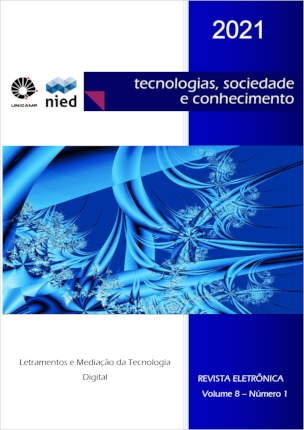Abstract
This article shows the results of a study that aimed to improve the literacy support proposal of a robotic mat originated after the methodology proposed by Emília Ferreiro, adapting it to the teaching reality. Technical and pedagogical requirements were raised, combined with Software Engineering and learning theories, with seven teachers through a workshop and an opinion poll. Some necessary improvement factors were found in relation to both software and hardware of the mat,and they were corrected through the development of a new software and hardware improvement, resulting in a more didactic and resistant tool.
References
ALMEIDA, A. et al. Indicadores para avaliação de software educacional com base no guia gdsm (goal driven software measurement). In: BRAZILIAN SYMPOSIUM ON COMPUTERS IN EDUCATION (SIMPÓSIO BRASILEIRO DE INFORMÁTICA NA EDUCAÇÃO-SBIE). Anais do Congresso Brasileiro de Informática na Educação (CBIE), 2018. p. 21-30. Disponível em:
https://www.br-ie.org/pub/index.php/sbie/article/view/7950. Acesso em: 05 jun. 2021
BARBOSA, S. D. J.; SILVA, B. Interação humano-computador. Rio de Janeiro: Elsevier Brasil, 2010.
BENITTI, F. B. V.; SEARA, E. F. R.; SCHLINDWEIN, L. M. Processo de Desenvolvimento de Software Educacional: proposta e experimentação. RENOTE - Revista Novas Tecnologias na Educação, v. 3, n. 1, 2005. Disponível em: https://www.seer.ufrgs.br/renote/article/viewFile/13849/8025. Acesso em: 05 jun. 2021
BOOCH, G.; RUMBAUGH, J.; JACOBSON, I. UML: guia do usuário. Rio de Janeiro: Elsevier Brasil, 2006.
BOTTENTUIT JÚNIOR, J. B.; MENEZ, M. R. C. S.; WUNSCH, L. P. Aplicativos móveis para a alfabetização e letramento no contexto do ensino fundamental. Revista Tempos e Espaços em Educação, v. 11, n. 01, p. 37-56, 2018. DOI: https://doi.org/10.20952/revtee.v11i01.9812. Disponível em: https://www.academia.edu/download/60231185/9812-29205-1-PB120190807-38883-ef7ewj.pdf. Acesso em: 13 jun. 2021
BRAGA, J. Cr. Objetos de aprendizagem, volume 2: metodologia de desenvolvimento. Santo André: Editora da UFABC, 2015.
CHEN, P.. Modelagem de dados: a abordagem entidade-relacionamento para projeto lógico. Makron Books do Brasil, 1990.
FERREIRA, P. et al. O Uso da Robótica como Apoio à Alfabetização e à Introdução do
Pensamento Computacional para Crianças. In: WORKSHOPS DO CONGRESSO BRASILEIRO DE INFORMÁTICA NA EDUCAÇÃO (CBIE 2019), 8., 2019, Brasília. Anais... Brazilian Computer Society (Sociedade Brasileira de Computação - SBC). p.238-247, 21 nov. 2019. Disponível em: http://dx.doi.org/10.5753/cbie.wcbie.2019.238. Acesso em: 13 jun. 2021.
FERREIRO, E.; TEBEROSKY, A.; LICHTENSTEIN, D. M. Psicogênese da língua escrita. Porto Alegre: Artes Médicas, 1986.
GROSSE-PUPPENDAHL, T. et al. Finding common ground: A survey of capacitive sensing in human-computer interaction. In: CHI CONFERENCE ON HUMAN FACTORS IN COMPUTING SYSTEMS, 2017. Proceedings… p. 3293-3315. Disponível em: https://dl.acm.org/doi/abs/10.1145/3025453.3025808. Acesso em: 13 jun. 2021
JÚNIOR, O. B.; AGUIAR, Y.; TAVARES, T. Abordagens para Avaliação de Softwares Educativos e sua Coerência com os Modelos de Qualidade de Software.BRAZILIAN SYMPOSIUM ON COMPUTERS IN EDUCATION (SIMPÓSIO BRASILEIRO DE INFORMÁTICA NA EDUCAÇÃO-SBIE); CONGRESSO BRASILEIRO DE INFORMÁTICA NA EDUCAÇÃO (CBIE), 5., 2016, Uberlândia. Anais... p. 270. Disponível em: http://www.br-ie.org/pub/index.php/sbie/article/view/6707. Acesso em 13 jun. 2021
LIAO, R. Ground shifting in capacitive sensing applications. Application Report SNOA952, Texas Instruments. 2016. Disponível em: https://www.ti.com/lit/pdf/snoa952. Acesso em: 13 jun. 2021
LIMA, J. S. de et al. Quali-EDU: Um processo de avaliação da qualidade de software educacional. In: BRAZILIAN SYMPOSIUM ON COMPUTERS IN EDUCATION (SIMPÓSIO BRASILEIRO DE INFORMÁTICA NA EDUCAÇÃO-SBIE). Anais do Congresso Brasileiro de Informática na Educação (CBIE), 2015. p. 229-238. Disponível em: http://www.br-ie.org/pub/index.php/sbie/article/view/5158. Acesso em: 05 jun. 2021
PAIVA SANCHIS, I. de; MAHFOUD, M.. Construtivismo: desdobramentos teóricos e no campo da educação. Revista Eletrônica de Educação, v. 4, n. 1, p. 18-33, 2010. Disponível em: http://www.reveduc.ufscar.br/index.php/reveduc/article/view/120. Acesso em: 13 jun. 2021
ROSSETTO, A. D. F. Sondagem digital da escrita de crianças em fase de alfabetização: uma abordagem tecnológica a partir da psicogênese da língua escrita. 2017. 71f. Dissertação (Mestrado em Ensino de Ciências Humanas, Sociais e da Natureza) - Universidade Tecnológica Federal do Paraná, Londrina, 2017. Disponível em: http://repositorio.utfpr.edu.br/jspui/handle/1/3079. Acesso em: 13 jun. 2021.
WING, J. M. Computational thinking. Communications of the ACM, v. 49, n. 3, p. 33-35, 2006.

This work is licensed under a Creative Commons Attribution 4.0 International License.
Copyright (c) 2021 Tecnologias, Sociedade e Conhecimento


